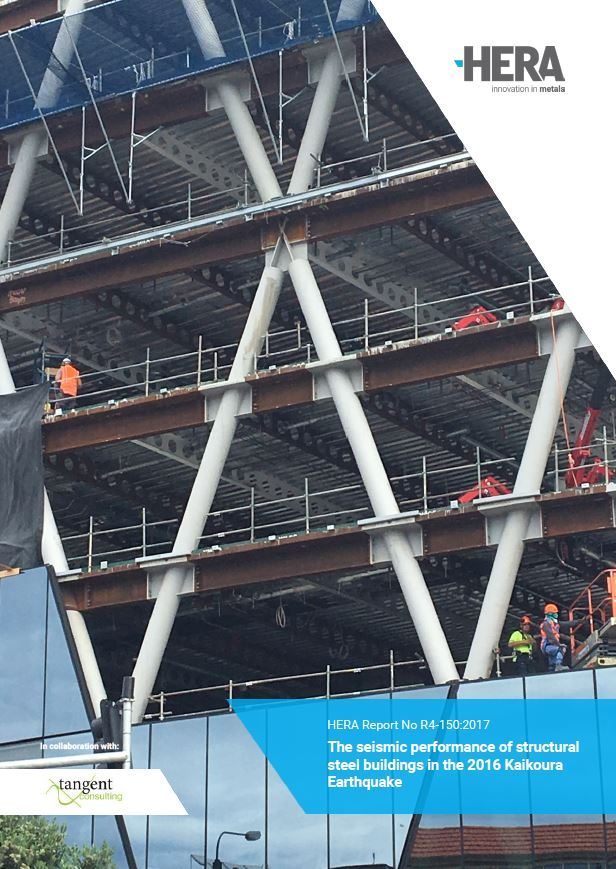Post-Kaikoura earthquake, little was mentioned about systemic failures in steel construction.
While this gave confidence that our structures performed well, we had to make sure. Taking an opportunity to learn if there could be any potential issues now, and in the future by commissioning research to pinpoint any weaknesses.
The research outcomes described in HERA Report R4-150: 2017 now confirm that there were no serious problems. Follow up on recommendations made as part of the research will also further improve steel construction performance in severe earthquake events.
Kaikoura Earthquake and its impact
The magnitude 7.8 Kaikoura Earthquake struck the North-Eastern region of the South Island on 14 November 2016. It was the largest earthquake in New Zealand since 1855. Involving the rupture of over six faults with a rupture zone extending 200km – the closest point to Wellington only 60km away.
The ground shaking resulted in between 80,000 and 100,000 landslides which blocked the coastal road and rail route to Kaikoura. There were also two fatalities attributed to this event.
No site-specific information has been obtained to determine if any structural steel buildings were subject to seismic demands in excess of design levels. As there was no immediate significant damage observable no disaster event was declared for Wellington. This meant there was no formal official government run investigation.
This coupled with a reluctance from parties associated with damaged steel buildings to reveal insight due to commercial sensitivity and legal liability – left us quite in the dark around how steel performed.
However, the understanding is that the level of demand was in excess of the ultimate limit state (ULS) force based elastic design level for many buildings and damage expected.
Best known are the significant failures of concrete framed buildings with pre-cast floor systems in Wellington. Leading to some early decisions to demolish buildings such as Statistics House, with many more currently on the investigation list.
Committing to learning from events like these is crucial
You only have to look back on our history to see that New Zealand is a country prone to earthquakes. That’s why at HERA, we believe understanding how our industry’s structures truly perform in these types of events is key if we’re to continue keeping our communities safe during seismic activity.
Not surprisingly, the lack of information on the performance of structural steel buildings post Kaikoura Earthquake was of concern to us. So much so, that we commission research from Tangent Consultant Structural Engineer Alistair Fussell to inform us better.
The investigation consisted of field observations and data collected from building officials, structural engineers, steel fabricators, academics and from a literature review of media, technical publications and websites.
What did we discover?
Our study found that structural steel buildings in the Wellington region performed well during the earthquake, with one notable exception – the Queensgate cinema and car parking complex.
Additionally, four examples of damage to steel buildings were noted, one being the vulnerability of gusset plate connections to a sway mode of behavior.
Overall, our research indicated there are no deficiencies in New Zealand seismic design practice for steel building structures at this time.
Moving forward
What continues to ring true is the importance of following established procedures and avoiding the use of details with known poor seismic performance – such as eccentric cleats in compression of seismic resisting systems.
One of our key recommendations coming from this investigation is to consider the feasibility of a confidential industry reporting mechanism for design and construction problems – similar to the SCOSS/CROSS initiative in the UK to facilitate learning from such incidents.
Recommendations have also been made to prepare practice notes for design engineers to promote good detailing practice with respect to tension only braces.
There’s also a need to consider out-of-plan actions when designing gusset plate connections in seismic load resisting braced frames are concerned. Further research is suggested as there’s currently no recognised procedure in New Zealand that appropriately accounts for this mode of failure.
Be confident in steel construction
Our research confirms that steel construction in the Kaikoura earthquake performed equally to that positively documented in the Royal Commission Reports for the Christchurch earthquakes.
It’s a message which needs to be spread by everyone involved!
However, as an industry we can’t rest on our laurels. We have to address the pinpointed areas for improvement – including educating and learning about best design practice.
We also ask those involved in remedying steel construction building failures to let us know of any further issues which our research may have overlooked by contacting our General Manager Structural Systems Dr Stephen Hicks.

